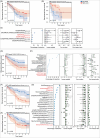A strategy for multimodal integration of transcriptomics, proteomics, and radiomics data for the prediction of recurrence in patients with IDH-mutant gliomas
- PMID: 40214613
- PMCID: PMC12141979
- DOI: 10.1002/ijc.35441
A strategy for multimodal integration of transcriptomics, proteomics, and radiomics data for the prediction of recurrence in patients with IDH-mutant gliomas
Abstract
Isocitrate dehydrogenase-mutant gliomas are lethal brain cancers that impair quality of life in young adults. Although less aggressive than glioblastomas, IDH-mutant gliomas invariably progress to incurable disease with unpredictable recurrence. A better classification of patient risk of recurrence is needed. Here, we describe a multimodal analytical pipeline integrating imaging, transcriptomic, and proteomic profiles using machine learning to improve patient stratification with novel signatures of patient risk of recurrence based on gene expression, protein level, and imaging. Additionally, we describe the biological characteristics of IDH-mutant glioma subtypes categorized by positron emission tomography (PET) and histology, and we reinforce the integration of positron emission tomography (PET) metrics in the classification of IDH-mutant gliomas. We identify a gene signature (KRT19, RUNX3, and SCRT2) and a protein signature (ATXN10, EIF4H, ITGAV, and NCAM1) associated with an increased risk of early recurrence. Furthermore, we integrated these markers with imaging-derived features, obtaining a better stratification of IDH-mutant glioma patients in comparison to histomolecular classification alone.
Keywords: IDH‐mutant glioma; multimodal integration; proteomic; radiomic; transcriptomic.
© 2025 The Author(s). International Journal of Cancer published by John Wiley & Sons Ltd on behalf of UICC.
Conflict of interest statement
The authors declare no conflicts of interest.
Figures






References
MeSH terms
Substances
Grants and funding
LinkOut - more resources
Full Text Sources
Medical
Research Materials
Miscellaneous

